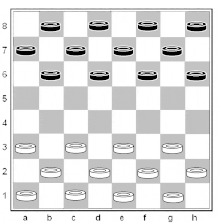This article needs additional citations for verification. (June 2022) |
 | |
| Genres | Board game Abstract strategy game |
|---|---|
| Players | 2 |
| Setup time | < 1 minute |
| Playing time | Varies, chess clocks can be used |
| Chance | None |
| Skills | Strategy, tactics |
| Synonyms | Stolbovye shashki Towers draughts |
Bashni (Russian: ба́шни, towers), also known as column draughts, multi-level checkers, and rarer Chinese checkers, is a variation of draughts, known in Russia since the 19th century. The game is played according to the basic rules of Russian draughts, with the main difference being that draughts being jumped over are not removed from the playing field but are instead placed under the jumping piece (draught or tower). The resulting towers move across the board as one piece, obeying the status of the upper draught. When a tower is jumped over, only the upper draught is removed from it. If, as a result of the combat, the top draught changes colour, ownership of the tower passes on to the opposing player. Based on Bashni, but according to the basic rules of English draughts, world chess champion Emanuel Lasker developed the draughts game "Laska" and, in 1911, published its description. Lasker described towers that can only be "double-layered": i.e. there can be no alternation of colors. He also showed that during the game the number of game pieces either remains constant or decreases. Column draughts are a subject of interest for the mathematical Sciences: combinatorics, theory of paired zero-sum games, etc.